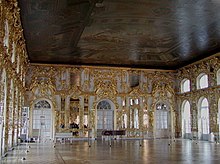Ballroom
 From Wikipedia - Reading time: 10 min
From Wikipedia - Reading time: 10 min
This article has multiple issues. Please help improve it or discuss these issues on the talk page. (Learn how and when to remove these messages)
|


A ballroom or ballhall is a large room inside a building, the primary purpose of which is holding large formal parties called balls. Traditionally, most balls were held in private residences; many mansions and palaces, especially historic mansions and palaces, contain one or more ballrooms. In other large houses, a large room such as the main drawing room, long gallery, or hall may double as a ballroom, but, a good ballroom should have the right type of flooring, such as hardwood flooring or stone flooring (usually marble or stone).[citation needed]. For most styles of modern dance, a wooden sprung floor offers the best surface.
In later times the term ballroom has been used to describe nightclubs where customers dance, the Top Rank Suites in the United Kingdom for example were also often referred to as ballrooms. The phrase "having a ball" has grown to encompass many events where person(s) are having fun, not just dancing.
Ballrooms are generally quite large, and may have ceilings higher than other rooms in the same building. The large amount of space for dancing, as well as the highly formal tone of events have given rise to ballroom dancing. The largest balls are now nearly always held in public buildings, and many hotels have a ballroom. They are also designed large to help the sound of orchestras carry well throughout the whole room.
A special case is the annual Vienna Opera Ball, where, just for one night, the auditorium of the Vienna State Opera is turned into a large ballroom. On the eve of the event, the rows of seats are removed from the stalls, and a new floor, level with the stage, is built.
Sometimes ballrooms have stages in the front of the room where the host or a special guest can speak. That stage can also be used for instrumentalists and musical performers.
List of hardwood US floor ballrooms
[edit]
This list only includes ballrooms with permanent wood floors. The size of the floor only includes the largest contiguous area without obstructions. The websites and materials about some places add up multiple spaces, rooms, and balconies, and floors. However, this list ranks ballrooms based on the size of one single open space with a hardwood floor.
See also
[edit]- Aragon Ballroom (Ocean Park, Santa Monica, California)
- Clärchens Ballroom in Berlin, Germany
- Ballroom an album of Irish music by De Dannan
- Nightclub
References
[edit]- ^ This rough estimate is based upon photos and not from measurements. Two unofficial pages say that the ballroom is 45,000 square feet, and that the building itself is 300 ft x 150 ft. [1] Archived 2012-03-22 at the Wayback Machine [2] Archived 2011-07-11 at the Wayback Machine From pictures Archived 2013-08-18 at the Wayback Machine, the dancable area without columns is currently smaller than the building although very large. It was billed as the "Largest Dancing Pavilion on the Great Lakes," in David Nasaw, Going out: the rise and fall of public amusements,(Cambridge, Massachusetts: Harvard University Press, 1999), p. 90.
- ^ [3] Archived 2011-09-17 at the Wayback Machine[4] Archived 2012-10-05 at the Wayback Machine[5] Archived 2012-03-22 at the Wayback Machine
- ^ "The Cotillion – Concerts and Events in Wichita, Kansas – Home". Archived from the original on 2010-11-28. Retrieved 2010-09-08.[6] Archived 2010-12-30 at the Wayback Machine
- ^ "iowaballroom.com/p/act/valair.html" (PDF). valairballroom.com. Archived from the original (PDF) on 2022-03-11. Retrieved 2011-04-14.
- ^ "Event Rentals at Hollywood Ballroom Dance Center, Silver Spring, MD". hollywoodballroomdc.com. Archived from the original on 2013-10-05. Retrieved 2013-10-01.
- ^ The building is 70' x 122' but the dance floor sits in from the walls approximately four feet and is raised up a few inches. 62' X 116' = 7192
- ^ "Austin TX entertainment, events, food, movies, music | Austin360.com". Archived from the original on 2012-03-29.
- ^ Lisa Light, Destination Bride, (Georgetown, ON: North Light Books, 2005), p. 170.
- ^ estimate based on architectural drawing Archived 2011-07-19 at the Wayback Machine
- ^ Savage, Rebecca Binno; Greg Kowalski (2004). Art Deco in Detroit. Arcadia Publishing. pp. 98–104 Although this page says just 5,000 Archived 2011-07-08 at the Wayback Machine
- ^ "Connecticut Flooring Contractors". Retrieved 2 December 2023.
- ^ Not open to the public
- ^ 81' x 63' http://www.iowaballroom.com/p/act/ep_wloo.html Archived 2011-02-01 at the Wayback Machine
- ^ The floor is definitely larger, but the size is irregular. This estimate is based on this floor plan Archived 2011-07-19 at the Wayback Machine
- ^ [7] Archived 2011-08-04 at the Wayback Machine[8] Archived 2011-10-03 at the Wayback Machine
- ^ capacity of 6,000 people Ralph G. Giordano, Country & Western Dance, Santa Barbara, CA: ABC-CLIO, 2010 p.42-3.
Further reading
[edit]- Robert Meyer,"Millennium Maple – Glorious, Historic, Legendary, Treasured Ballroom Dance Floors", Amateur Dancers, Jan/Feb 2000, Issue#123.
- Geronimo Trevino. Dance Halls and Last Calls: A History of Texas Country Music. Lanham, MD: Republic of Texas Press 2002. ISBN 1-55622-927-5. Copyright
 KSF
KSF